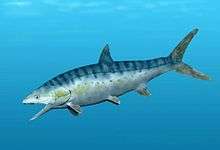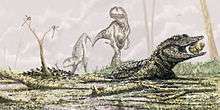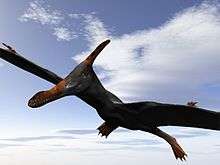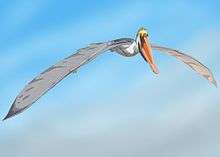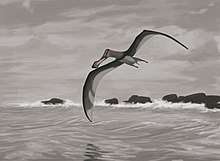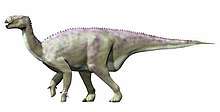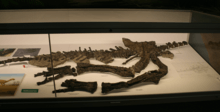Wessex Formation
The Wessex Formation is a fossil-rich English geological formation that dates from the Berriasian to Barremian stages (about 145–125 million years ago) of the Early Cretaceous. It forms part of the Wealden Group and underlies the younger Vectis Formation and overlies the Durlston Formation.[1] The dominant lithology of this unit is mudstone with some interbedded sandstones. It is exposed in both the Isle of Purbeck and the Isle of Wight. While the Purbeck sections are largely barren of vertebrate remains, the Isle of Wight sections are well known for producing the richest and most diverse fauna in Early Cretaceous Europe.
| Wessex Formation Stratigraphic range: Late Berriasian–Barremian, 140–125 Ma | |
|---|---|
 Exposure of the Wessex Formation west of Chilton Chine | |
| Type | Geological formation |
| Unit of | Wealden Group |
| Sub-units | Coarse Quartz Grit (in Dorset) |
| Underlies | Vectis Formation |
| Overlies | Durlston Formation |
| Thickness | up to 1000 m near Swanage |
| Lithology | |
| Primary | mudstone |
| Other | sandstone, ironstone & conglomerate |
| Location | |
| Region | Southern England |
| Country | |
| Extent | Dorset, Isle of Wight, offshore Wessex Basin |
| Type section | |
| Named for | Wessex |
| Named by | Daley and Stewart |
| Location | Bacon Hole, Mupe Bay |
| Year defined | 1979 |
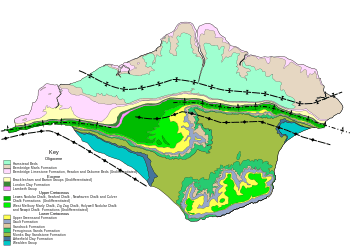 Exposure of the Wessex and Vectis Formations on the South Coast of the Isle of Wight, shown in turquoise, exposures in Dorset not shown. | |
Nomenclatural History
The Wessex Formation has historically alternately been called the "Variegated Marls And Sandstones", a name used by W. J. Arkell in his 1947 map of the Isle of Purbeck[2] as well as the "Wealden Marls" [3] It was given its current formal name by Daley and Stewart in 1979[4]
Stratigraphy and Lithology
Introduction
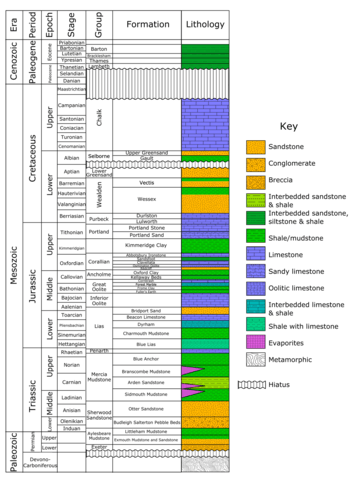
The Wessex Formation forms part of the Wealden Group within the Wessex Basin, an area of subsidence since Permo-Triassic times. The basin is located along southern half of the Isle of Wight and Purbeck, extending offshore into the English Channel. The Wealden Group is also exposed significantly in the Weald Basin, which has a separate stratigraphic succession. The Wealden Group is not widely present elsewhere in Britain, as these areas were tectonic highs where no sediment deposition was taking place. The formation has limited exposure as it has been deeply buried beneath the subsequent Lower Greensand. Selbourne and Chalk Groups, as well as being very vulnerable to erosion. It has been exposed at the surface due to the creation of anticlinal structures as a distant effect of the formation of the Pyrenees as part of the Alpine Orogeny during the Paleogene.[5]
The Wessex Formation in the Isle of Purbeck
The exposure in of the Wessex Formation in the Isle of Purbeck is largely confined to a thin belt on the south side of the Purbeck Ridge and is best exposed at Swanage,[6] Lulworth Cove[7] and Worbarrow Bay.[8] One notable persistent horizon within the Purbeck sections of the formation is the "Coarse Quartz Grit", an up to 6 metre thick sequence of conglomeratic ironstone, with many beds including numerous centimetre sized subangular to rounded pebbles predominantly of vein derived quartz, hence the name.[8] This horizon is present throughout the Purbeck outcrops of the Wessex Formation.
The Wessex Formation of the Isle of Wight
The Isle of Wight succession has two primary exposures, The major one being the several kilometre long section along the South West coastline around Brighstone Bay, and another smaller exposure on the South East coast near Yaverland. While the formation taken as a whole dates from the Berriasian to the Barremian, only the uppermost part of the formation is exposed on the Isle of Wight. With less than 200 metres of exposed composite stratigraphic thickness, and which dates from latest Hauterivian to Barremian. The boundary between the two ages lies near the Pine Raft horizon.[9] This makes the formation coeval with upper portion of the Weald Clay in the Weald Basin. The primary lithology of the exposed portion of the formation on the Isle of Wight consists of featureless purple-red overbank mudstone, interbedded with sandstones. The environment of deposition was a floodplain within a narrow. east-west oriented valley.[10] The climate at the time of deposition is considered to be semi-arid, based on the presence of pedogenic calcrete nodules within the mudstones.[11] The aforementioned "Pine Raft" horizon found near the base of the exposed portion of the formation includes calcitized conifer trunks up to metre in diameter and 2–3 metres long.[12]
Plant Debris Beds
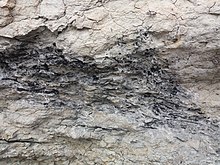
A notable feature of the formation are the so-called "Plant debris beds". These consist of a basal matrix supported conglomerate, grading upwards into grey mudstone with lignitic plant debris, including large trunk fragments of the extinct conifer Pseudofrenelopsis present in the upper portion. These were formed by sheet flood deposits induced by storms that filled pre-existing topographic lows like oxbow lakes and abandoned channels in the floodplain depositional environment.[13] The debris beds do not form a continuous horizon throughout the formation, but are laterally extensive over tens of metres. Many of the wood fragments in the debris beds are cemented together with large nodules of pyrite, suggesting depositional conditions were anoxic.[14] Most fossils within the formation are associated with the debris beds, but are mostly disarticulated individual bones, suggesting a long subaerial exposure prior to burial. Many of the larger bones are encased in hard nodules of sideritized mudstone. Plant debris beds also exist within the Swanage section, but are noticeably sparse in fossils.
"Hypsilophodon bed"
While most fossils are associated with the plant debris beds, a notable exception is the "Hypsilophodon bed" present near the top of the formation, an up to 1 metre thick bed of silty red-green mudstone, with two separate horzions that have produced almost exclusively over a hundred complete and articulated skeletons of Hypsilophodon, sometimes even with preserved tail tendons. The bed is laterally extensive, being persistent for over a kilometre. It has been recently suggested that the accumulation of skeletons were a mass mortality event caused by a crevasse splay.[15] Just above the "Hypsilophodon bed" the red mudstones of the Wessex Formation change to the transitional light coloured sandstone "White rock" and overlying laminatinated grey mudstones of the Vectis Formation, caused by the changing of environmental conditions from that of a floodplain to coastal lagoon conditions, caused by the early Aptian marine transgression. The transition to the Vectis Formation is also present in Swanage but thins out and disappears westward, having an erosive unconformity with the Lower Greensand Group or the Gault in these areas, often with a basal pebble bed.
Fauna
Invertebrates
Invertebrates are commonly preserved in the Wessex Formation. Freshwater bivalves can be found including unionids such as Margaritifera, Nippononaia, and Unio. These bivalves are helpful in reconstructing what the freshwater paleoenvironment may have been like during the formation's deposition. Specimens of Viviparus, a genus of freshwater snail, have also been found. While compression fossils of insects are found in the overlying Vectis Formation, all insect fossils in the Wessex formation are found as inclusions in amber. Amber can be found present as a rare component in other plant debris beds in the Wessex formation both on the Isle of Wight and the Isle of Purbeck, however the only significant concentration and where all of the inclusions have been found is a lag channel in the L6 plant debris horizon just south-east of Chilton Chine. Only three species from the amber have been formally described, Cretamygale chasei a mygalomorph spider, and Dungeyella gavini[16] and Libanodiamesa simpsoni, both chironomid midges. Most of the other taxa in the table come from mentions in the paper describing the latter. However several images of some of the undescribed taxa have been released from various sources, including multiple chironomids, a therevid dipteran, and dryinid hymenopteran[17]
Color key
|
Notes Uncertain or tentative taxa are in small text; |
Arthropods
| arthropods of the Wessex Formation | ||||||
|---|---|---|---|---|---|---|
| Genus | Species | Location | Stratigraphic Position | Abundance | Note | Images |
|
C. chasei[18] |
Chilton Chine | L6 Plant debris bed | Single specimen | Mygalomorph spider, has been described from a specimen found in amber. | See article | |
| Dungeyella | D. gavini[19] | Chilton Chine | L6 Plant debris bed | Multiple specimens | a tiny buchonomyiine chironomid | See article |
| Libanodiamesa | L. simpsoni[20] | Chilton Chine | L6 Plant debris bed | Single specimen | Prodiamesinae chironomid, genus also known from the Lebanese amber | |
| Chironomidae |
Indeterminate |
Chilton Chine | L6 Plant debris bed | 44% of all arthropod inclusions | Uncertain how many taxa represented, likely at least two. At least one is a tanypodian with a wingspan twice that of Dungeyella. | |
| Therevidae | Indeterminate | Chilton Chine | L6 Plant debris bed | At least one specimen | At least one specimen figured | 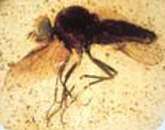 |
| Diptera | Indeterminate | Chilton Chine | L6 Plant debris bed | Multiple specimens | Uncertain how many taxa represented | |
| Dryinidae | Indeterminate | Chilton Chine | L6 Plant debris bed | At least one specimen | At least one specimen figured, presumably male due to presence of wings | 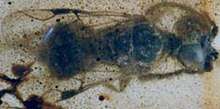 |
| Hymenoptera |
Indeterminate |
Chilton Chine | L6 Plant debris bed | Multiple specimens | Uncertain how many taxa represented | |
| Blattodea |
Indeterminate |
Chilton Chine | L6 Plant debris bed | Single specimen | ||
| Coleoptera |
Indeterminate |
Chilton Chine | L6 Plant debris bed | Single specimen | ||
| Curculionoidea? |
Indeterminate |
Represented by a boring in a gymnospermous seed.[21] |
||||
Cartilaginous fishes
| Cartilaginous fishes of the Wessex Formation | ||||||
|---|---|---|---|---|---|---|
| Genus | Species | Location | Stratigraphic Position | Abundance | Note | Images |
|
H. basanus |
Ergetenodus? |
| ||||
|
Indeterminate 1 |
Yaverland bed 38, L9 |
|||||
|
Indeterminate 2 |
Yaverland bed 38, L9 |
|||||
|
Indeterminate 3 |
Yaverland bed 38, L9 |
|||||
|
Lonchiodon |
L. breve |
Yaverland bed 38 |
||||
|
L. striatum |
Yaverland bed 38, L9 |
51.43% of total chondrichthyan taxa in L9 |
||||
|
Indeterminate 1 |
Yaverland bed 38, L9 |
|||||
|
Indeterminate 2 |
Yaverland bed 38, L9 |
35.86% of total chondrichthyan taxa in Yaverland bed 38 |
||||
|
Indeterminate 3 |
Yaverland bed 38, L9 |
|||||
|
Hylaeobatis |
H. problematica |
|||||
|
Palaeoscyllium |
Indeterminate |
|||||
|
Parvodus |
P. heterodon |
|||||
|
Indeterminate |
||||||
|
Vectiselachos |
V. ornatus |
|||||
Ray-finned fish
| Ray-finned fishes of the Wessex Formation | ||||||
|---|---|---|---|---|---|---|
| Genus | Species | Location | Stratigraphic Position | Abundance | Notes | Images |
|
Indeterminate |
||||||
|
Indeterminate |
| |||||
|
Indeterminate |
||||||
|
Indeterminate |
||||||
|
Indeterminate |
||||||
|
Ocloedus |
Indeterminate |
|||||
|
Indeterminate |
||||||
|
Indeterminate |
||||||
|
Indeterminate |
 | |||||
Lissamphibians
| Amphibians of the Wessex Formation | ||||||
|---|---|---|---|---|---|---|
| Genus | Species | Location | Stratigraphic Position | Abundance | Notes | Images |
| Wesserpeton[22] | W.evansae | L2 and Yaverland 38 | Albanerpetontid amphibian | |||
|
Anura[23] |
Indeterminate |
Multiple | 1: Yaverland 38 2: L2 and Yaverland 38 3: L2 and Yaverland 38 4: Yaverland 38 5: Yaverland 38 | At least 5 distinct taxa distinguished by characters in their ilium | ||
| Urodela | Indeterminate | Multiple | 1: L2, L14 and Yaverland 33 and 38 2: L9 and Yaverland 38 3: unnamed bed in Compton bay and Yaverland 38 | At least 3 distinct taxa distinguished by their atlas vertebrae | ||
Squamates
| Squamates of the Wessex Formation | ||||||
|---|---|---|---|---|---|---|
| Genus | Species | Location | Stratigraphic Position | Abundance | Notes | Images |
| Meyasaurus | Indeterminate | Yaverland | Yaverland bed 38 | Teeth and a partial lower jaw | Genus also known from Spain | |
| Anguimorpha[23] |
indeterminate |
Multiple plant debris beds | 1st taxon L14 and L2, 2nd L2 and Yaverland bed 38, 3rd Yaverland bed 38 | At least 3 distinct taxa represented by isolated teeth, maxilla and lower jaw fragments | ||
| Scincomorpha[23] |
indeterminate |
Multiple plant debris beds | 1: L14 and Yaverland 38 2: Yaverland 38, 3: L2 and Yaverland 38 4,5: Yaverland bed 38 6:L2, L14 and Yaverland 38 7,8,9: Yaverland 38 10: L2, L14 and Yaverland 38 | At least 10 distinct taxa represented by isolated teeth, maxilla and lower jaw fragments, some of which are paramacellodids based on the common occurrence of osteoderms typical of this clade. | ||
Turtles
| Turtles of the Wessex Formation | ||||||
|---|---|---|---|---|---|---|
| Genus | Species | Location | Stratigraphic Position | Material | Notes | Images |
|
H. nopcsai |
Shell and skull material |
| ||||
|
Indeterminate |
Shell fragments |
Housed at the Dinosaur Farm Museum, Isle of Wight |
||||
|
Indeterminate |
Shell |
Housed at the Dinosaur Isle Museum, Isle of Wight |
||||
| Pleurosternon | Indeterminate | |||||
|
B. brodiei |
||||||
Crurotarsans
| Crurotarsans of the Wessex Formation | ||||||
|---|---|---|---|---|---|---|
| Genus | Species | Location | Stratigraphic Position | Abundance | Notes | Images |
|
A. hooleyi |
Disputed, either uppermost Wessex or lowermost Vectis |
| ||||
| A. epikrator[25] | Hanover Point | Mostly complete skull and partial dentaries and associated postcranial material | ||||
| Bernissartia | Indeterminate | 40 Isolated teeth |
| |||
|
H. willetti |
||||||
|
K. aprosdokiti[26] |
| |||||
|
Indeterminate |
||||||
| Vectisuchus | V. leptognathus | Barnes High | Just below base of Vectis formation | "Partial semi-articulated skeleton" | ||
Plesiosaurs
| Plesiosaurs of the Wessex Formation | ||||||
|---|---|---|---|---|---|---|
| Genus | Species | Location | Stratigraphic Position | Abundance | Notes | Images |
|
Indeterminate |
Compton Bay |
Vertebra |
||||
|
Indeterminate |
Tie pits, atherfield |
Propodial |
Leptocleididae? |
|||
Mammals
| Mammals of the Wessex Formation | ||||||
|---|---|---|---|---|---|---|
| Genus | Species | Location | Stratigraphic Position | Material | Notes | Images |
|
E.clemensi[28] |
Multiple debris beds | L9, Yaverland bed 38 and CL3 |
Teeth |
|||
| ?Gobiconodon | Indeterminate | Yaverland | Yaverland bed 38 | Teeth | ||
|
L.valdensis |
Teeth |
|||||
|
Y.gassoni |
Multiple debris beds | Mandible from Yaverland bed 38, isolated teeth from L2, L9 and L14 |
Mandible Fragment and isolated teeth |
 | ||
|
Indeterminate |
Multiple debris beds | Yaverland bed 38 and L9 | Two lower molars, likely belonging to the same taxon, distinct from other dryolestid teeth so likely to be a new genus and species. | |||
| Eutriconodonta | Indeterminate | Yaverland | Yaverland bed 38 | Lower left molariform | ||
|
Indeterminate |
Premolars |
Eutheria? |
||||
Pterosaurs
| Pterosaurs of the Wessex Formation | ||||||
|---|---|---|---|---|---|---|
| Genus | Species | Location | Stratigraphic Position | Material | Notes | Images |
|
C. trimicrodon |
Skull and rostrum fragments |
An ornithocheirid |
| |||
|
I. latidens |
Partial skeleton and skull, and referred mandible fragment |
An istiodactylid |
| |||
|
Indeterminate |
Found throughout the sub basin |
Teeth |
Two other species, distinct from I.latidens |
|||
|
Indeterminate |
Rostrum fragment |
An ornithocheirid |
| |||
|
Indeterminate |
Humerus |
|||||
|
Indeterminate |
Tooth, potentially a gnathosaurine |
|||||
|
Wightia[30] |
W. declivirotris |
Rostrum fragment |
First tapejarid from the formation |
|||
Dinosaurs
Ornithischians
| Ornithischians reported from the Wessex Formation | |||||||
|---|---|---|---|---|---|---|---|
| Genus | Species | Synonyms | Location | Stratigraphic Position | Material | Notes | Images |
|
H. foxii |
Hypsilophodon bed | Many partial skeletons |
| ||||
|
Indeterminate |
Teeth | Closely resemble the cheek teeth of the heterodontosaurid Tianyulong | |||||
|
I. bernissartensis |
Specimens classified as Iguanodon seelyi are referable to this species |
| |||||
|
M. atherfieldensis |
Dollodon bampingi, Proplanicoxa?[31] |
| |||||
|
P. foxii |
Polacanthoides ponderosus? |
| |||||
|
Indeterminate |
Distinct from P. foxii.[32] |
||||||
|
V. canaliculatus |
Multiple partial skeletons | A dryosaurid |
| ||||
Sauropods
| Sauropods reported from the Wessex Formation | ||||||
|---|---|---|---|---|---|---|
| Genus | Species | Location | Stratigraphic Position | Material | Notes | Images |
|
C. gigas |
"Several cervical vertebrae."[33] |
|||||
|
E. foxi |
"Dorsal vertebra."[33] |
Perhaps a somphospondylan?[34] | ||||
|
I. valdensis |
"Several caudal vertebrae."[33] |
|||||
|
O. armatus |
"Tooth."[35] |
|||||
|
O. eucamerotus |
"Ischia and pubis.",[33] regarded as an "undiagnostic titanosauriform of uncertain affinities." |
|||||
|
O. hulkei |
One dorsal vertebra.[36] |
|||||
| Undescribed Sauropod (Barnes High sauropod) | Indeterminate | "Partial postcranial skeleton, including presacral vertebrae, anterior caudal vertebrae, girdle and limb elements"[37] | Currently in private collection and unavailable to researchers. Known informally as "the Barnes High sauropod". Possibly the same as Eucamerotus[37] | |||
| Angloposeidon | Indeterminate | One cervical vertebra and possible associated centrum[38] | Represents a large animal 20 metres or greater in length. Known informally as "Angloposeidon". Perhaps a somphospondylan? | |||
|
Indeterminate |
Scapula, radius and ulna, several cervical sacral and caudal vertebrae and isolated teeth from multiple individuals |
Taxon has possible close affinities with Demandasaurus and Nigersaurus |
||||
|
Indeterminate |
Two isolated large middle caudal vertebra, one isolated large cervical vertebra |
|||||
Theropods
| Theropods reported from the Wessex Formation | ||||||
|---|---|---|---|---|---|---|
| Genus | Species | Location | Stratigraphic Position | Material | Notes | Images |
|
Indeterminate |
Isolated teeth |
Possibly an Enantiornithe and a Hesperornithid present | ||||
|
A. pusillus |
"Sacrum and pubes."[39] |
| ||||
|
B. walkeri |
Isolated teeth, manus bones, vertebrae and skull material |
A spinosaurid possibly synonymous with Suchosaurus cultridens |
| |||
|
C. foxi |
"Vertebrae."[40] |
A compsognathid |
||||
|
C. oweni |
"Vertebrae."[40] |
A possible oviraptorosaur |
||||
|
E. lengi |
"Partial skull and skeleton."[41] |
|||||
|
N. salerii |
Cranial and postcranial remains of at least four individuals. |
| ||||
|
O. cluniculus |
A dubious species of dromaeosaurid, once misidentified as a pterosaur |
|||||
|
Indeterminate |
Teeth |
Dubious, uncertain referral on the genus level |
||||
| Tetanurae | Indeterminate | Chilton Chine | Partial pubes and femur[42] | Distinct from Neovenator and Baryonyx. Currently in private collection. | ||
|
T. daviesi |
"Cervical vertebrae."[43] |
A theropod of uncertain classification, possibly an ornithomimosaur (this assignment has been questioned by both Mortimer and Naish).[44][45] |
||||
| Undescribed coelurosaur | Indeterminate | Partial associated skeleton | Apparently small. In private collection and undescribed. | |||
|
Indeterminate |
Isolated teeth |
May belong to a proceratosaurid.[46] |
||||
|
Y. bitholus |
Yaverland | Known from a "partial skull roof comprising both frontals and parts of the right postorbital and left orbitosphenoid". A second specimen is known but has not been formally published. |
A maniraptoran of uncertain classification, originally identified as an ornithischian. |
|||
Flora
Spermatophytes
| Spermatophytes reported from the Wessex Formation | ||||||
|---|---|---|---|---|---|---|
| Genus | Species | Location | Stratigraphic Position | Material | Notes | Images |
|
Indeterminate |
Stem fragment (IWCMS.2010.7) |
|||||
|
Indeterminate |
Dubious referral |
|||||
|
Indeterminate |
||||||
|
Pseudofrenelopsis |
P. parceramosa |
Incredibly abundant, sometimes found as entire segments of the trunk |
Member of Cheirolepidiaceae | |||
| Brachyphyllum | B. obesum | |||||
| Pityites | P. solmsii | |||||
| Bennettitales | ||||||
Pteridophytes
| Pteridophytes reported from the Wessex Formation | ||||||
|---|---|---|---|---|---|---|
| Genus | Species | Location | Stratigraphic Position | Material | Notes | Images |
|
Indeterminate |
||||||
|
Indeterminate |
||||||
|
W. reticulata |
Multiple specimens |
|||||
See also
References
- "Wessex Formation". The BGS Lexicon of Named Rock Units. British Geological Survey.
- Arkell, W. J. (1947). "The Geology of the country around Weymouth, Swanage, Corfe and Lulworth". Memoir of the Geological Survey of Great Britain.
- Osbourne White, H. J. (1921). "A short account of the geology of the Isle of Wight". Memoir of the Geological Survey of Great Britain.
- Daley, B.; Stewart, D. J. (1979). "Weekend field meeting: The Wealden Group in the Isle of Wight". Proceedings of the Geologists' Association. 90: 51–54. doi:10.1016/S0016-7878(79)80031-0.
- Parrish, Randall R.; Parrish, Claire M.; Lasalle, Stephanie (May 2018). "Vein calcite dating reveals Pyrenean orogen as cause of Paleogene deformation in southern England". Journal of the Geological Society. 175 (3): 425–442. Bibcode:2018JGSoc.175..425P. doi:10.1144/jgs2017-107. ISSN 0016-7649.
- West, Ian. "Swanage Bay and Ballard Cliff". Geology of the Wessex Coast of Southern England.
- West, Ian. "Lulworth Cove, Dorset". Geology of the Wessex Coast of Southern England.
- West, Ian. "Worbarrow Bay". Geology of the Wessex Coast of England.
- Hughes, N.F.; McDougall, A.B. (January 1990). "New Wealden correlation for the Wessex Basin". Proceedings of the Geologists' Association. 101 (1): 85–90. doi:10.1016/S0016-7878(08)80208-8.
- Insole, Allan N.; Hutt, Stephen (September 1994). "The palaeoecology of the dinosaurs of the Wessex Formation (Wealden Group, Early Cretaceous), Isle of Wight, Southern England". Zoological Journal of the Linnean Society. 112 (1–2): 197–215. doi:10.1111/j.1096-3642.1994.tb00318.x.
- Robinson, Stuart A.; Andrews, Julian E.; Hesselbo, Stephen P.; Radley, Jonathan D.; Dennis, Paul F.; Harding, Ian C.; Allen, Perce (March 2002). "Atmospheric pCO 2 and depositional environment from stable-isotope geochemistry of calcrete nodules (Barremian, Lower Cretaceous, Wealden Beds, England)". Journal of the Geological Society. 159 (2): 215–224. Bibcode:2002JGSoc.159..215R. doi:10.1144/0016-764901-015. ISSN 0016-7649.
- Radley, Jonathan D.; Allen, Percival (April 2012). "The Wealden (non-marine Lower Cretaceous) of the Wessex Sub-basin, southern England". Proceedings of the Geologists' Association. 123 (2): 319–373. doi:10.1016/j.pgeola.2012.01.002.
- Sweetman, Steven C.; Insole, Allan N. (June 2010). "The plant debris beds of the Early Cretaceous (Barremian) Wessex Formation of the Isle of Wight, southern England: their genesis and palaeontological significance". Palaeogeography, Palaeoclimatology, Palaeoecology. 292 (3–4): 409–424. Bibcode:2010PPP...292..409S. doi:10.1016/j.palaeo.2010.03.055.
- Radley, Jon D. (January 1994). "Stratigraphy, palaeontology and palaeoenvironment of the Wessex Formation (Wealden Group, Lower Cretaceous) at Yaverland, Isle of Wight, southern England". Proceedings of the Geologists' Association. 105 (3): 199–208. doi:10.1016/S0016-7878(08)80119-8.
- Coram, Robert A.; Radley, Jonathan D.; Martill, David M. (March 2017). "A Cretaceous calamity? The Hypsilophodon Bed of the Isle of Wight, southern England". Geology Today. 33 (2): 66–70. doi:10.1111/gto.12182.
- Jarzembowski, E.; Azar, D.; Nel, A. (2009-04-24). "A new chironomid (Insecta: Diptera) from Wealden amber (Lower Cretaceous) of the Isle of Wight (UK)". Geologica Acta. 6 (3): 285–291. doi:10.1344/105.000000257. ISSN 1696-5728.
- Jarzembowski, E. A. (27 March 2015). "Fossil resins from England (Conference abstract)" (PDF). Amberif 2015: SUCCINITE AND SELECTED FOSSIL RESINS OF EUROPE: LOCALITIES, PROPERTIES, ARCHAEOLOGY: 18–20.
- "FIRST BRITISH MESOZOIC SPIDER, FROM CRETACEOUS AMBER OF THE ISLE OF WIGHT , SOUTHERN ENGLAND". 26 September 2001.
- "Fossil specimen : MIWG IWCMS.1994.99 – Holotype". GB3D Type Fossils.
- Baranov, Viktor; Giłka, Wojciech; Zakrzewska, Marta; Jarzembowski, Edmund (March 2019). "New non-biting midges (Diptera: Chironomidae) from Lower Cretaceous Wealden amber of the Isle of Wight (UK)". Cretaceous Research. 95: 138–145. doi:10.1016/j.cretres.2018.11.012.
- Legalov, A & A. Jarzembowski, Edmund. (2017). First record of a weevil (Coleoptera: Nemonychidae) from the Lower Cretaceous (Wealden) of southern England. Cretaceous Research. 82. 10.1016/j.cretres.2017.10.006.
- "A new albanerpetontid amphibian from the Barremian (Early Cretaceous) Wessex Formation of the Isle of Wight, southern England - Acta Palaeontologica Polonica". www.app.pan.pl. Retrieved 2017-10-11.
- Sweetman, S. C. 2006. The tetrapod microbiota of the Wessex Formation (Lower Cretaceous, Barremian) of the Isle of Wight, UK. 127-129. In: Barrett, P. M. and Evans, S. E. (eds.) 2006. Ninth international symposium on Mesozoic terrestrial ecosystems and biota, abstracts and proceedings. 187 pp.
- Salisbury, S.W.; Naish, D. (2011). "Crocodilians". In Batten, D.J. (ed.). English Wealden Fossils. The Palaeontological Association. pp. 305–369.
- Ristevski, Jorgo; Young, Mark T.; de Andrade, Marco Brandalise; Hastings, Alexander K. (April 2018). "A new species of Anteophthalmosuchus (Crocodylomorpha, Goniopholididae) from the Lower Cretaceous of the Isle of Wight, United Kingdom, and a review of the genus". Cretaceous Research. 84: 340–383. doi:10.1016/j.cretres.2017.11.008. ISSN 0195-6671.
- Sweetman, S.C.; Pedreira-Segade, U.; Vidovic, S.U. (2014). "A new bernissartiid crocodyliform from the Lower Cretaceous Wessex Formation (Wealden Group, Barremian) of the Isle of Wight, southern England" (PDF). Acta Palaeontologica Polonica. doi:10.4202/app.00038.2013.
- KEAR, B. P. and BARRETT, P. M. (2011), Reassessment of the Lower Cretaceous (Barremian) pliosauroid Leptocleidus superstes Andrews, 1922 and other plesiosaur remains from the nonmarine Wealden succession of southern England. Zoological Journal of the Linnean Society, 161: 663–691. doi:10.1111/j.1096-3642.2010.00648.x
- Sweetman, Steven C. (September 2009). "A New Species of the Plagiaulacoid Multituberculate MammalEobaatarfrom the Early Cretaceous of Southern Britain". Acta Palaeontologica Polonica. 54 (3): 373–384. doi:10.4202/app.2008.0003. ISSN 0567-7920.
- SWEETMAN, STEVEN C. (November 2008). "A Spalacolestine Spalacotheriid (Mammalia, Trechnotheria) from the Early Cretaceous (Barremian) of Southern England and ITS Bearing on Spalacotheriid Evolution". Palaeontology. 51 (6): 1367–1385. doi:10.1111/j.1475-4983.2008.00816.x. ISSN 0031-0239.
- Martill, David M.; Green, Mick; Smith, Roy; Jacobs, Megan; Winch, John (April 2020). "First tapejarid pterosaur from the Wessex Formation (Wealden Group: Lower Cretaceous, Barremian) of the United Kingdom". Cretaceous Research. 113: 104487. doi:10.1016/j.cretres.2020.104487.
- McDonald, Andrew T. (2011). "The status of Dollodon and other basal iguanodonts (Dinosauria: Ornithischia) from the upper Wealden beds (Lower Cretaceous) of Europe". Cretaceous Research. 33: 1–6. doi:10.1016/j.cretres.2011.03.002.
- Pond, Stuart, et al. A critical new ankylosaur specimen from the Wessex Formation of the Isle of Wight. No. e1742. PeerJ PrePrints, 2015.
- "Table 13.1," in Weishampel, et al. (2004). Page 271.
- Campbell, Amy, Paul Upchurch, and Phillip D. Mannion. The anatomy and relationships of Eucamerotus foxi (Dinosauria, Sauropoda) from the Early Cretaceous of England. No. e3247v1. PeerJ Preprints, 2017.
- "Table 13.1," in Weishampel, et al. (2004). Page 261.
- "Table 13.1," in Weishampel, et al. (2004). Page 266.
- "Sauropod dinosaurs". Field Guide to English Wealden Fossils. Palaeontological Association. 2011.
- Naish, Darren; Martill, David M.; Cooper, David; Stevens, Kent A. (December 2004). "Europe's largest dinosaur? A giant brachiosaurid cervical vertebra from the Wessex Formation (Early Cretaceous) of southern England". Cretaceous Research. 25 (6): 787–795. doi:10.1016/j.cretres.2004.07.002.
- "Table 4.1," in Weishampel, et al. (2004). Page 76.
- "Table 4.1," in Weishampel, et al. (2004). Page 78.
- "Table 5.1," in Weishampel, et al. (2004). Page 112.
- Benson, Roger B. J.; Brusatte, Stephen L.; Hutt, Stephen; Naish, Darren (2009). "A new large basal tetanuran (Dinosauria: Theropoda) from the Wessex Formation (Barremian) of the Isle Of Wight, England". Journal of Vertebrate Paleontology. 29 (2): 612–615. doi:10.1671/039.029.0202. ISSN 0272-4634.
- "Table 8.1," in Weishampel, et al. (2004). Page 167.
- Naish, D. (2014, June 3). "Ostrich dinosaurs invade Europe! Or do they?". Retrieved from https://blogs.scientificamerican.com
- Mortimer, M. (2014, May 26). "Is Thecocoelurus an ornithomimosaur?". Retrieved from http://theropoddatabase.blogspot.co.uk
- Rauhut, O.W.M.; Milner, A.C.; Moore-Fay, S. (2010). "Cranial osteology and phylogenetic position of the theropod dinosaur Proceratosaurus bradleyi (Woodward, 1910) from the Middle Jurassic of England". Zoological Journal of the Linnean Society. 158 (1): 155–195. doi:10.1111/j.1096-3642.2009.00591.x.
- Batten, D. J. (ed.) 2011. English Wealden Fossils. The Palaeontological Association, London.
.jpg)
